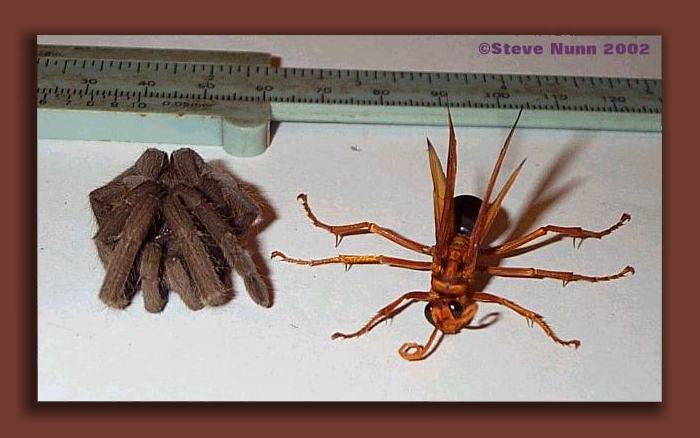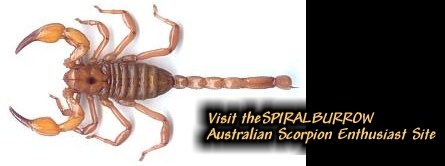Steven C. Nunn: Sarina, Queensland, 15 October 2001.
Email Me:----->
Observations on the behaviour of a predatory wasp, Hemipepsis sp. (Hymenoptera, Pompilidae), and its prey, Selenocosmia crassipes (Araneae, Theraphosidae)
Steven C. Nunn: Sarina, Queensland, 15 October 2001.
Email Me:----->

The following account of events took place on the 10th September 2001, at about 1.30pm. The outside temperature was approximately 25 degrees Celsius.

On this particular day I was out walking on one of the many hills that surround my hometown, Sarina, on the Central Queensland coast. Sub-tropical vegetation dominates these hills, providing habitat for a wide array of native wildlife. As I walked, I observed a giant spider wasp flying extremely low to the ground. The wasp was later identified by Queensland Museum entomologists as a Hemipepsis sp. This particular specimen had a total length of 34mm (head, thorax and abdomen), a wingspan of 55mm; and a leg span of 76mm.
The wasp appeared to be deliberately flying very slowly and extremely close to the ground. Upon landing, the wasp promptly scurried down the web-lined burrow of a theraphosid spider, Selenocosmia crassipes. The burrow was located underneath a large rock, which, when removed, revealed its web-lined retreat. Unlike some other theraphosids, S. crassipes is known as an opportunistic burrower and will often not build an extensive burrow as such, but create a web-lined shelter utilising almost anything found in the natural environment (including rocks, logs, crevices etc.). This being the case, I was able to observe (at extremely close quarters), the interactions between the predator wasp and its spider prey.
The S. crassipes (6th to 7th instar) observed in the burrow, was hunched into a tight, cowardly stance at the far end of its retreat. As the wasp closed in, the spider stayed motionless and made no attempt to confront or attack the intruder, but instead appeared to be trying to lay low in an attempt to remain undetected. The wasp swiftly positioned itself on top of the spider, delivering a single sting to the side of the abdomen. Almost instantly, the S. crassipes was paralyzed, and the wasp dismounted. Immediately following this, in what could be described as a "frenzy", the Hemipepsis sp. hurriedly inspected the area surrounding the spider within the retreat. At no stage did I notice any vibrating of the wasp’s wings (a known trait of spider wasps, Pepsis spp., from Central America), nor did the Hemipepsis sp. try to remove the spider from the burrow (Hemipepsis sp. are known to either dig their own burrows, use empty burrows, or utilise the existing burrow within which the prey was captured).
Interestingly enough, the wasp displayed no apparent reaction to my intrusion. At this stage the wasp was captured in a specimen jar. The wasp is now preserved in 70% ethanol solution, and is to become part of the entomology collection housed at the Queensland Museum. The S. crassipes was also collected and as of the time of writing, is still alive. During this time, the spider has shown only a slight improvement from its original incapacitated state. She is still quite paralyzed and has regained only very slight and restricted movement.
Hopefully, through further observations, I may be able to determine an approximate time period for the length of paralysis by this species of spider wasp in this particular situation. This of course is dependent on whether or not the spider will survive and make a full recovery. Never the less, I intend to continue recording my observations and look forward to providing a follow up report on the outcome of this event.

